![]()
Aircraft and Artwork: The Iconic Aviation Collection
Military Voice
Air Force | Air Force 100 | Iconic Aviation Collection
March 11th, 2022
6 minute read
A collection to remember. The Iconic Aviation Collection brings together the sensational artwork of Australian artist Drew Harrison, with the love of aviation and the RAAF shown by so many of the Australian public.
Based in Adelaide, South Australia, Drew is an award-winning practising professional artist and an acrylic paint specialist. Creating artworks that are characteristically unique and a fresh take in the military art space, Drew has a meticulous eye for the incredible detail and accuracy captured in his paintings. Drew was previously commissioned by the Air Force Shop to create an artwork to truly memorialise the magnificent milestone of the Air Force Centenary.
Continuing our wonderful relationship with Drew, six new works have been commissioned, creating highly researched and beautifully detailed artworks of six iconic aircraft operated by the RAAF.
The Aircraft and the Art
The F-111: Seek, Strike, and Return by Drew Harrison
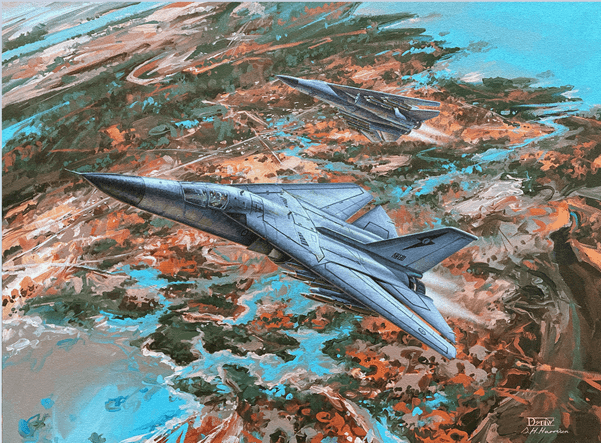 Seek, Strike, and Return by Drew Harrison, featuring two RAAF F-111s.
Seek, Strike, and Return by Drew Harrison, featuring two RAAF F-111s.
Capturing the service of the affectionately named aircraft known by the Australians as ‘The Pig’ and encapsulating the controversial beginnings through to retirement from service in December 2010, Seek, Strike, and Return¸ is the detailed work from Drew Harrison capturing two F-111’s in mid-flight over northern Australia.
With a controversial entry to RAAF service, the General Dynamics F-111 faced an uphill battle from technical difficulties and budget blowouts in the beginning. These teething problems quickly gave way as the ubiquitous and highly capable F-111 strike bomber attained several achievements in the RAAF before its retirement in December 2010.
The F-111 holds a lasting legacy of its status as a regional deterrent and is fondly remembered in this sensational artwork.
The C-130 Hercules: First and Foremost by Drew Harrison
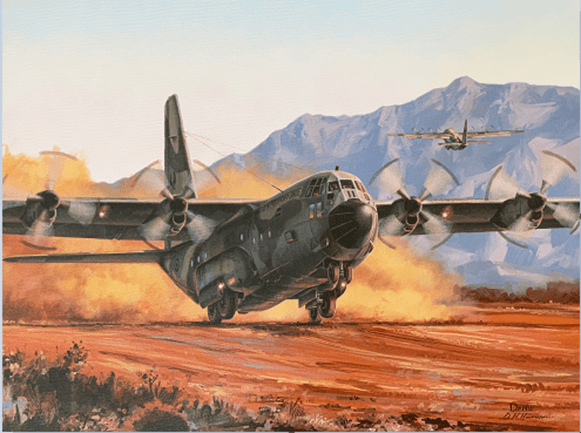 First and Foremost featuring a RAAF C-130 Hercules on the runway.
First and Foremost featuring a RAAF C-130 Hercules on the runway.
Few aircraft have achieved the same legendary status as the Lockheed C-130 Hercules. The RAAF’s association with the transport began in December of 1958 when the first of twelve A models replaced an ageing Dakota fleet. However, this was only the start of a long association with the C-130s. Over sixty years the C-130 fleet has operated many roles including tactical along with humanitarian and disaster relief.
The bright and colourful work from Drew Harrison, First and Foremost, features the C-130 Hercules during take-off on a short, unsealed runway in a nod to the features and roles undertaken by this legendary aircraft during its time in operation in the Middle East Area of Operations (MEAO) beginning in February 2003.
The Avro Lancaster: Into The Cauldron by Drew Harrison
Into the Cauldron by Drew Harrison featuring the Avro Lancaster Bomber AG-G at night.
The daring Lancaster Bomber remains an iconic aircraft for the RAAF, best known for its operation by RAAF squadrons during operations undertaken in WWII. One of the RAF heavies, the Lancaster Bomber, was operated by RAAF squadrons as part of the RAF controlled Bomber Command, taking the fight to Germany during the mid-war period. Commemorate this legendary aircraft through Drew Harrison’s compelling artwork Into the Cauldron. This stirring artwork captures the service of the Avro Lancaster Bomber AG-G as part of the Bomber Command, showing the Lancaster Bomber on a night operation over Germany in stunning detail. One of many dangerous night operations completed by these daring aircraft, be transported to the skies above Berlin by this vibrant work.
The P-51D Mustang: Cutting the Lines by Drew Harrison
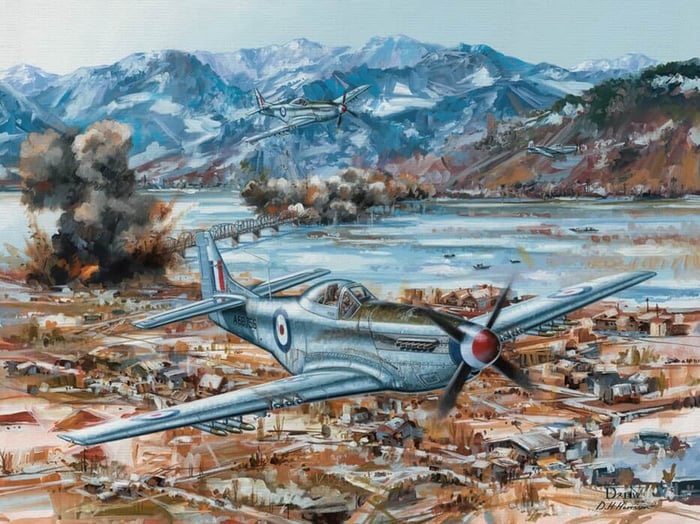 Two P-51D Mustangs fly after a successful operation in Drew Harrison's Cutting the Lines.
Two P-51D Mustangs fly after a successful operation in Drew Harrison's Cutting the Lines.
Soon after the cessation of hostilities in WWII the RAAF committed 76, 77 and 82 squadrons as part of the British commonwealth occupational forces (BCOF) in Japan. 77 Squadron remained on station and was due to be recalled in 1950, however, this was cancelled on 25th June when hostilities over the Korean peninsula erupted. The Australian squadron led by S/Ldr Louis ‘Lou’ Spence (DFC and Bar, MiD) was immediately committed as part of the United Nations response and became second only to the United States in conducting initial combat operations over Korea. 77 Squadron Mustangs began their duties on 2nd July 1950, and on 17th December four aircraft including F/Lt Des Murphy in P-51D, A68-756 targeted the bridge. Destruction was attained solely with bombs. Drew Harrison’s unique artwork, Cutting the Lines, shows the aftermath of this operation. 77 Squadron received a Presidential Citation from The Republic of Korea for operations over the peninsula along with numerous individual awards and citations for the hard-working crews.
The Catalina: Black Cat in the Shadows by Drew Harrison
 Black Cat in the Shadows by Drew Harrison. A Catalina 'Black Cat' flies on operation.
Black Cat in the Shadows by Drew Harrison. A Catalina 'Black Cat' flies on operation.
Depicting one of the most valuable aircraft during the early stages of the war in the Pacific, the striking Black Cat in the Shadows artwork is a stunning recognition of the Consolidated PBY Catalina patrol flying boat. Capturing the long-range aircraft at night during the opening stages of the Pacific War, these impressive aircraft completed a number of operations. Flown at night these slow-speed aircraft were painted with a black exterior, earning the nickname ‘Black Cats’. 43 Squadron RAAF was established as a Maritime Patrol unit equipped with the Catalina in early 1943. By 1945 the squadron continued flying many types of operations including harassment against targets of opportunity across the South West Pacific.
The CAC Sabre: Cobra Sabres by Drew Harrison
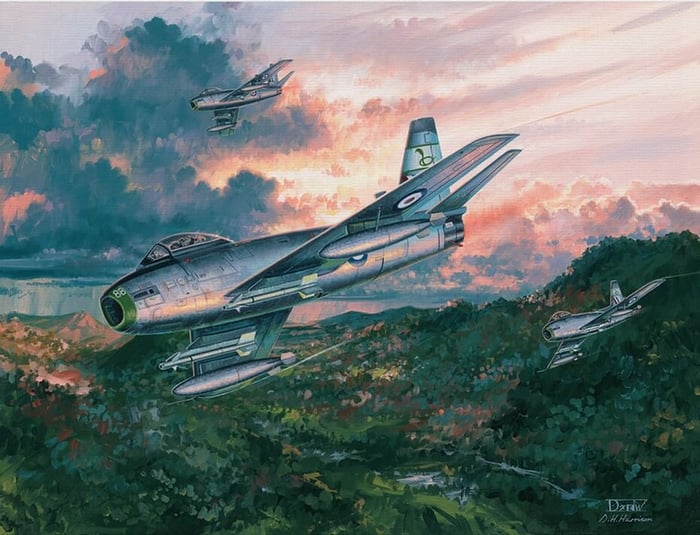 Cobra Sabres by Drew Harrison. Three CAC Sabres fly while based in Ubon, Thailand.
Cobra Sabres by Drew Harrison. Three CAC Sabres fly while based in Ubon, Thailand.
The CA-27 Sabre was a highly redesigned Australian version of the North American F-86. Featuring a more powerful Avon engine, altered fuselage and increased air intake, the CA-27 Sabre was used by 79 Squadron RAAF to maintain patrols and provide air cover at the major airbase in Ubon, Thailand. Drew Harrison’s vibrant artwork Cobra Sabres captures the CAC Sabre decorated with a green cobra on the tail, an emblem briefly adopted by 79 Squadron during their time in Ubon.
The Iconic Aviation Collection is a monumental gallery of some of the most beloved aircraft of the RAAF over the past 100 years, from war to modern operations these aircraft have served the RAAF and have become an important part of the RAAF story for many. These sensational, incredibly detailed, and meticulously researched paintings from Drew Harrison are a testament to the love and care for these aircraft from the Australian public.
Related Articles
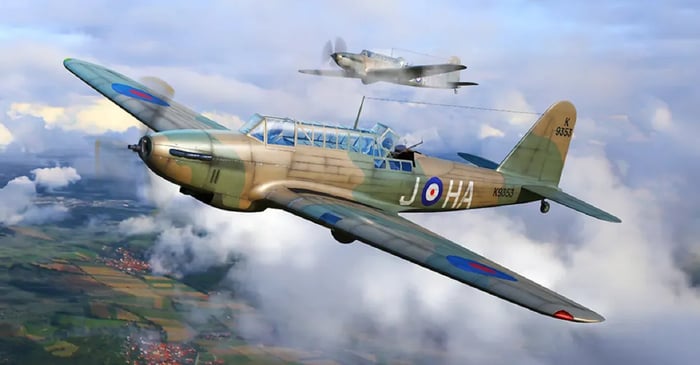
The Therapeutic Power of Model Building: Why Adults Are Turning to Aircraft Kits
3 minute read
May 14th, 2025
![]()
A Limited Edition Collection That Leaves a Lasting Impression.
4 minute read
March 11th, 2022

Lovable Limited Lapel Pins Are Here
3 minute read
March 11th, 2022
Test




-u2hwh.png)




